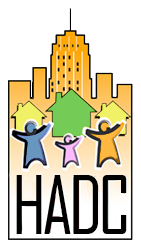TIMELINE
1978
HADC is incorporated as Hispanic American Development Corporation after a faith-based initiative led by First Presbyterian Church of Allentown becomes aware that blight is overspreading Allentown’s residential core.
HADC begins rehabbing vacant blighted properties, taking on an average of 8 to 12 projects each year to create affordable housing opportunities for low-to moderate income families.
1983
HADC changes its name to Housing Association & Development Corporation to distinguish it from Hispanic American Organization after funders and others report confusion over the similarity in their names.
1984
HADC and Community Action Committee of the Lehigh Valley form a partnership to develop and operate the Sixth Street Shelter in Allentown to address the problem of homelessness. Later CACLV takes over management and ownership of the property.
1991
HADC uses a new federal program, created five years earlier, to imbed Low-Income Housing Tax Credits into the development and construction of a three-unit apartment building at 616 N. Sherman Street. The investors who provided the project financing in exchange for the tax credits were all private individuals, not big institutions, as would later be the norm in all LIHTC projects across the country.
1992
HADC partners with the City of Allentown, Allentown Housing Authority, Allentown Economic Development Corporation, Lehigh Conference of Churches and Lehigh Valley Child Care Centers to develop Alliance Hall at Sixth and Chew streets. HADC manages nine accessible apartments reserved for people with disabilities on the third floor.
2000
David W. Evans becomes HADC’s third Executive Director after serving nine years as a member of HADC’s Board of Directors, including a time as President.
2002
HADC changes its method of working when it establishes a permanent construction crew to rehab houses instead of hiring subcontractors from throughout the area to do the work. Evans recruits neighborhood residents with limited skills to earn full-time wages and benefits while receiving on-the-job training in the construction trades.
HADC’s Board of Directors makes the strategic decision to concentrate its blight remediation and affordable housing work on a 24-square block focus area bounded by Tilghman Street on the north, Linden Street on the south, Seventh Street on the west and the Jordan Creek on the east. It is one of the poorest urban concentrations in the Lehigh Valley.
2004
A fast-moving middle-of-the-night fire on Labor Day weekend destroys seven houses and leaves five others unlivable in the 400 block of Allentown’s North Street, in the heart of HADC’s focus area. HADC sees an opportunity to redevelop an entire block, a marked difference in approach to urban renewal from the scattered-site rehab that had been HADC’s development model.
2005
HADC crew begins its first project of entirely new construction when they start building the first of nine new four-bedroom townhouses along the south side of the 400 block of North Street. The homes will be sold to income-eligible first-time buyers.
HADC attracts corporate support and wins approval from Pennsylvania to launch a Neighborhood Partnership Program with long-term funding support from Air Products, Lehigh Valley Health Network, PPL Corporation and Wachovia (now Wells Fargo). The $200,000 in annual funding from the companies directly supports HADC’s affordable housing and community development work.
2009
HADC christens its 24-square-block focus area “Jordan Heights” as part of the implementation of a comprehensive neighborhood plan developed in collaboration with Community Action Development Corporation of Allentown with long-term funding from the Wachovia (later Wells Fargo) Regional Foundation. In time, the name catches on.
2010
HADC begins construction of Phase 2 of the North Street project, eventually constructing another 12 townhouses along the north side of the block, including four built to accessibility standards of the Americans with Disabilities Act. The homes will be sold to income-eligible first-time buyers
As work on Phase 2 of the North Street project progresses, the size of HADC’s construction crew grows – for a time expanding to 18 members – as the homebuilding work reaches its maximum.
2011
HADC renews the Neighborhood Partnership Program for another six years with $300,000 in annual commitments from Air Products, First Niagara Bank (now KeyBank), PPL Corporation and Wells Fargo. The funding directly supports HADC’s affordable housing and community development work.
2016
HADC launches YouthBuild Allentown in collaboration with Communities in Schools, The Literacy Center and Valley Youth House. The first class of YouthBuild students begins rehabbing a blighted house on Liberty Street while studying for the GED examination. The program provides job training, employment experience and a path to a high school graduation credential to young men and women who left school without graduating.
HOW HADC STARTED
It all began in 1978 when then-mayor Joseph S. Daddona gave a blighted house to the Hispanic American Organization of Allentown. It was the gift of a white elephant.
The Hispanic American Organization (HAO) was a new nonprofit organization, formed in response to the needs of Allentown’s growing Hispanic population, but focused more on education and job training than on housing. It accepted the mayor’s donation but simply did not have the resources or the expertise to take on a project as expensive and complex as gutting a house to its exterior walls and constructing an entirely new interior.
HAO had been formed by members of the congregation of First Presbyterian Church of Allentown. Although the church had moved two decades earlier from 31 N. Fifth Street (now the Allentown Art Museum) in downtown Allentown to its suburban campus at Cedar Crest Boulevard and Tilghman Street, the congregation did not forget its roots and remained connected to the city through its Community Ministry Committee.
The church committee was composed of an active group of go-getters. Some of them served on the board of HAO, and when they reported the dilemma the organization faced over what to do with the donated house, the Community Ministry Committee decided to act.
It assembled a coalition of religious organizations, including the Lutheran Synod of Northeastern Pennsylvania and Calvary Baptist Church, and together they conceived of the idea to create an entirely new organization dedicated to blight elimination and the development of affordable housing.
The idea was to receive donated blighted residential properties that the Allentown Redevelopment Authority was beginning to acquire in great numbers, rehab them, then sell the renovated houses at affordable prices to low- to moderate-income first-time buyers. The Lehigh Presbytery provided $25,000 in seed money, the Lutheran Synod of Northeastern Pennsylvania provided a $15,000 forgivable loan, and Air Products made a cash contribution after the company’s Vice President (later he was president), Dexter Baker, a member of the Community Ministry Committee, learned of the ambitious plan.
HADC was off and running.
The organizers named the new non-profit agency the Hispanic American Development Corporation. Several members of HAO’s Board of Directors took seats on the board of HADC, and the two organizations operated like sister agencies in the beginning.
But blight does not exclusively impact the Hispanic population, and it was never intended that HADC would sell houses to only Hispanic buyers, so the original name, Hispanic American Development Corporation, was not the best choice. Funders and public officials constantly confused HADC and HAO, so five years after it was founded, the board of HADC decided to change the name of the agency to render a clear distinction between the two.
Despite the confusion over the names Hispanic American Organization and Hispanic American Development Corporation, the letters H, A, D, C by then were firmly associated in many minds, connecting it automatically with the organization that renovated blighted houses. So when the Board of Directors of HADC were casting about for a new name, they decided to find one that fit the letters H, A, D, C.
It is lost to memory the identity of those who selected the new name and whether the discussion about the change was vigorous. What we do know is that on August 24, 1983, documents were signed that changed the name of HADC to Housing Association & Development Corporation.
Names change. Board and staff members come and go. For four decades, HADC has remained steadfast to is mission, connecting residents and resources to build sustainable neighborhoods.

